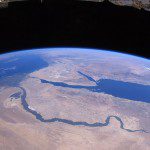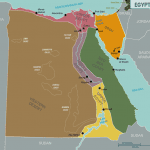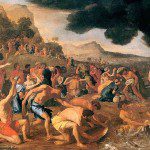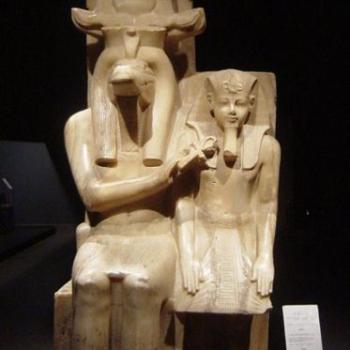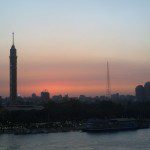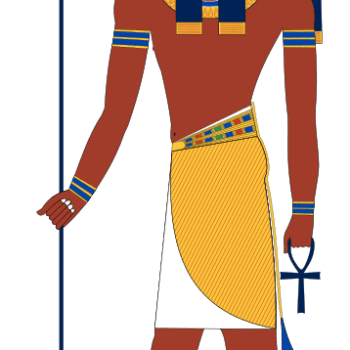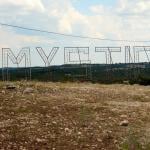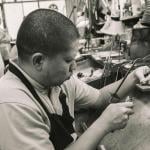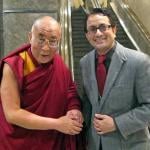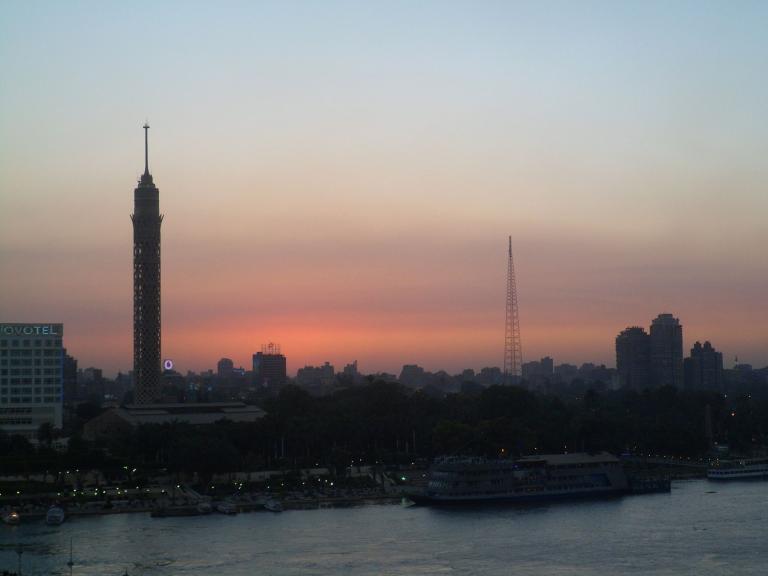
(It’s slightly weird, by the way, to speak of “Gezira Island” in English, since “Gezira” is simply the Arabic equivalent, pronounced in the dialect of Lower Egypt, of English “island.”)
My wife and I had a lot of fun this evening hosting a former student of mine and her husband for dinner at our hotel, outside on the shore of the River Nile. I maintain my policy of not revealing the identity of such folks, lest, simply because of their association with me, they become targets of my most obsessive critics. However, he is a newly retired professor of botany and evolutionary biology at a university in Texas and she participated in the intensive BYU Arabic program that I directed decades ago in Jerusalem. They are here as a Church service couple, and we spent the evening not only reminiscing but discussing the joys and the challenges of life and service in Cairo. (3 John 4.)

(Wikimedia Commons public domain photograph)
Prior to that, we went with most our group — some of them have still been arriving today — to Salah al-Din’s twelfth-century Citadel and Muhammad Ali’s nineteenth-century Ottoman-style mosque within it, and then, after lunch, to the stunning and still relatively new National Museum of Egyptian Civilization. This was our first time in it, and I was very, very impressed. The lighting and the displays are superb — everything that the old Egyptian Museum is not, but what I hope the new Grand Egyptian Museum will be on an even larger scale.
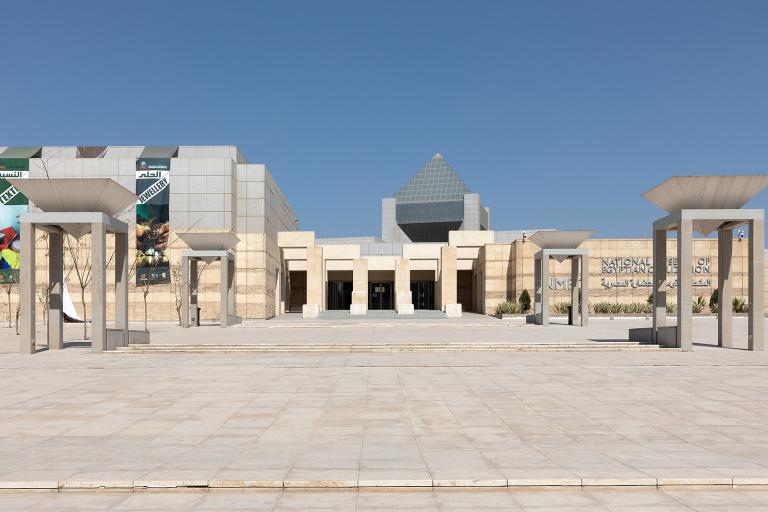
(Wikimedia Commons public domain image)
Newly posted on the website of the Interpreter Foundation: Interpreter Radio Show — October 8, 2023
Terry Hutchinson, John Gee, and Kevin Christensen combined for the 8 October 2023 episode of the Interpreter Radio Show with special guest Malcolm Adcock. They discussed Come, Follow Me New Testament lesson 45, tithing, and Malcolm’s new book, The Latter-day Saint Image in the British Mind, coauthored with Fred E. Woods.
The “New Testament in Context” portion of this show, for the Come, Follow Me New Testament lesson 45, “Jesus Christ, ‘the Author of Eternal Salvation’” on Hebrews 1–6, will also be posted separately on Tuesday, October 24.
The Interpreter Radio Show can be heard on Sunday evenings from 7 to 9 PM (MDT), on K-TALK, AM 1640, or you can listen live on the Internet at ktalkmedia.com.
The recording has been edited to remove commercial breaks.
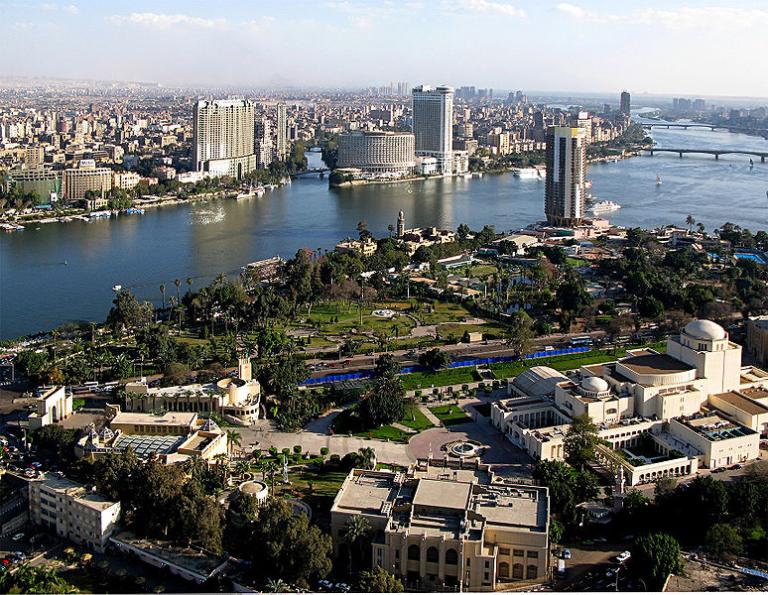
(Wikimedia Commons public domain)
I want to share with you a few passages from BYU Studies Quarterly 61/4 (2022. A special issue, it was created by Stephen O. Smoot, John Gee, Kerry Muhlestein, and John S. Thompson, and is entitled A Guide to the Book of Abraham.
Part 2 of the volume, “The Book of Abraham in the Ancient World,” consists of a fairly large number of short articles on various subjects, attempting to show how the Book of Abraham fits into its purported ancient setting or, in a few cases, how what we’re now learning about the ancient world sheds light on the content of the Book of Abraham. I will quote from several of those short articles here, generally focusing on “bottom line” declares that conclude detailed lines of evidence and argument.
“Ur of the Chaldees,” pages 67-70
“Taken together, the evidence from the Book of Abraham text and external archaeological and inscriptional sources can reasonably point us in the direction of modern northern Syria and southern Turkey as the ancient homeland of Abraham. While there are many questions that scholars still grapple with, enough evidence has surfaced over the years to paint an overall plausible picture of the historical and geographical world described in the Book of Abraham.” (70)
“Abraham and Idrimi,” pages 71-75
“The parallels between these two texts [the Book of Abraham and the Inscription of Idrimi], as well as other considerations, indicate that ‘the Book of Abraham belongs to the same specific literary tradition as Idrimi’s autobiography.’ This, naturally, raises the question, ‘How did Joseph Smith manage to publish in the Book of Abraham a story that closely matched a Middle-Bronze-Age Syrian autobiography that would not be discovered for nearly a hundred years?” The most plausible explanation is that the Book of Abraham belongs to that time period, genre of literature, and part of the world.” (75)
“Human Sacrifice,” pages 76-79
“Some of the evidence for this practice [of human sacrifice in ancient Egypt] dates to the likely time of Abraham (ca. 2000-1800 BC), and ‘the story [of an attempted sacrifice of Abraham] presented in the Book of Abraham matches remarkably well with the picture of ritual slaying’ in Egypt during the same period.” (77)
“While caution is still necessary because of gaps in the available data, enough evidence is available to indicate that “institutionally sanctioned ritual violence [in ancient Egypt] centered [on] two main ideas: interference with cult, and rebellion.’ This converges remarkably well with the Book of Abraham, offering a plausible historical context for Abraham’s near-sacrifice.” (78)
“The Idolatrous God Elkenah,” pages 80-82
“What do we know about the ancient god Elkenah? No deity of that name is mentioned in the King James Bible, but in the last century archaeologists have unearthed evidence of his worship. Elkenah is very likely the shortened form of the name of the Canaanite god ’el-qoneh-ha-ares, meaning ‘God who created the earth’ (or ‘God, creator of the earth’). Among the ancient Hittites living in Asia Minor he was known as Elkunirsha.” (80-81)
“What the evidence appears to indicate . . . is that, along with the other deities in the text, the god Elkenah mentioned in the Book of Abraham has very likely been identified in the ancient world.” (82)
“Sobek, the God of Pharaoh,” pages 83-87
“A strong case can be made for identifying the ‘god of Pharaoh’ in [Facsimile 1 of] the Book of Abraham as the Egyptian [crocodile] deity Sobek. . . . The worship of Sobek was popular in Egypt in Abraham’s day.” (83)
“From this evidence unknown in Joseph Smith’s day, we can say the following about “the god of Pharaoh” in the Book of Abraham and Facsimile 1. First, the god in question is arguably the crocodile deity Sobek. Second, among other things, Sobek was closely associated with the Pharaoh of Egypt. Third, Sobek was especially venerated by King Amenemhet III, a possible contemporary of Abraham. Fourth, and finally, specimens of Sobek iconography have been recovered from the likely region of Abraham’s homeland during the right period for Abraham’s lifetime (the Middle Bronze Age).
“All of this reinforces the argument that “the [B]ook of Abraham accurately describes an aspect of the ancient world about which Joseph Smith could have known little or nothing.” (86-87)
“The Plain of Olishem,” pages 88-91
“There is definitely an ancient site with the name Ulisum or Ulishum.
“There is no agreement as to the precise location of Ulisum, but it can most likely be identified in a specific general region (west of the Euphrates in southern Turkey). Many scholars are currently interested in exploring where precisely Ulisum may be in this region.
“Olishem is a name from the Book of Abraham, which matches the phonetics and time period of the known site of Ulis[h]um.
“A likely region of the ancient Ulisum matches well with some geographic interpretations of the Book of Abraham. . . .
“Future discoveries may shed further light on this topic, but for now it can be said that Ulisum is plausible and promising (though not yet definitive) evidence for the Book of Abraham’s Olishem.” (90-91)
Posted from Cairo, Egypt


